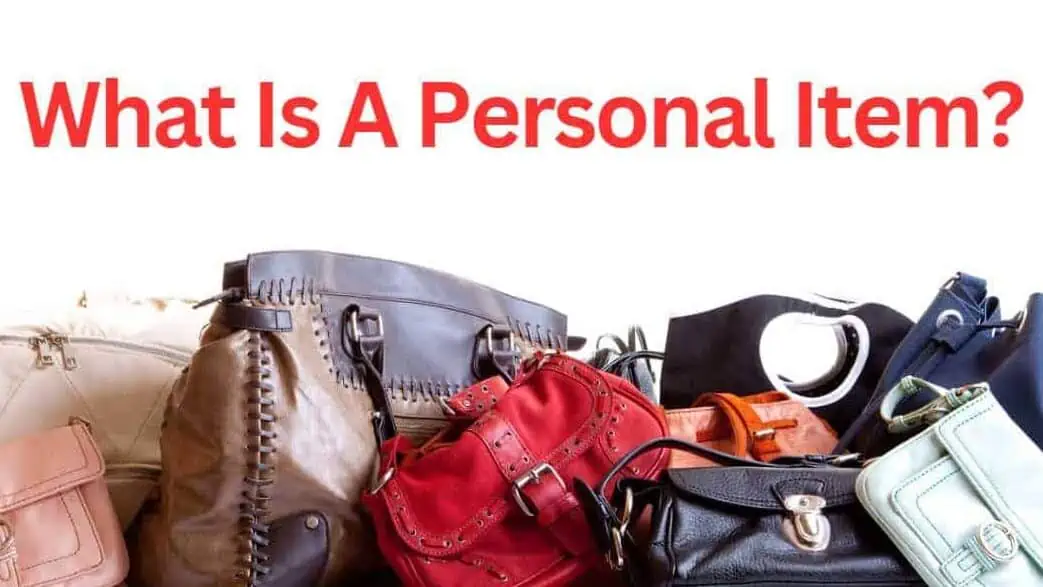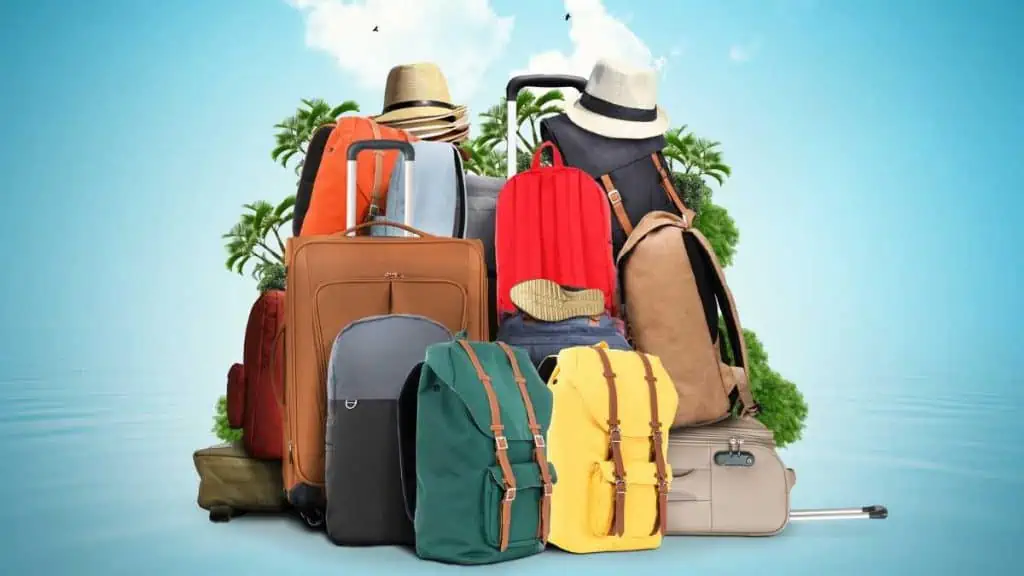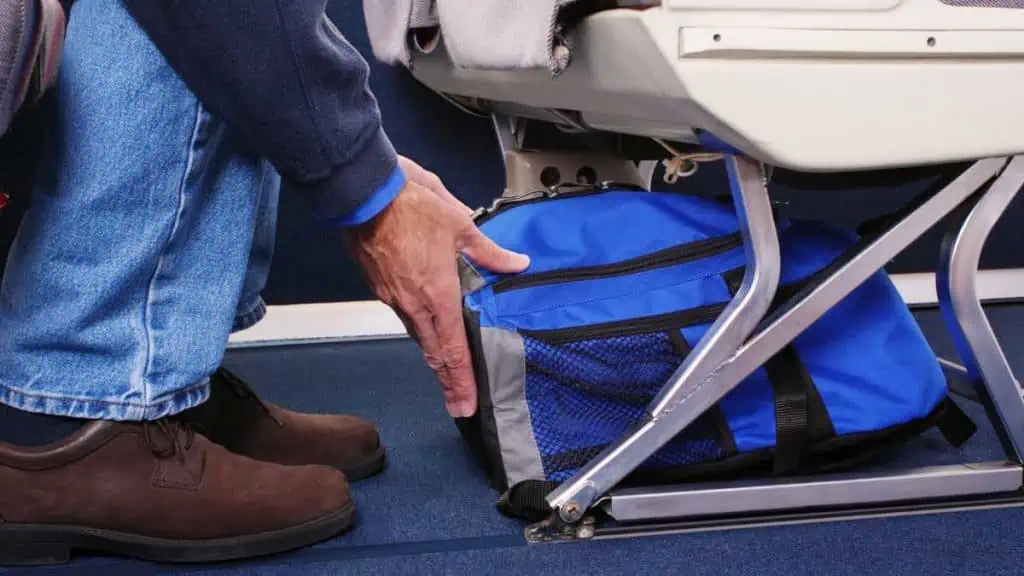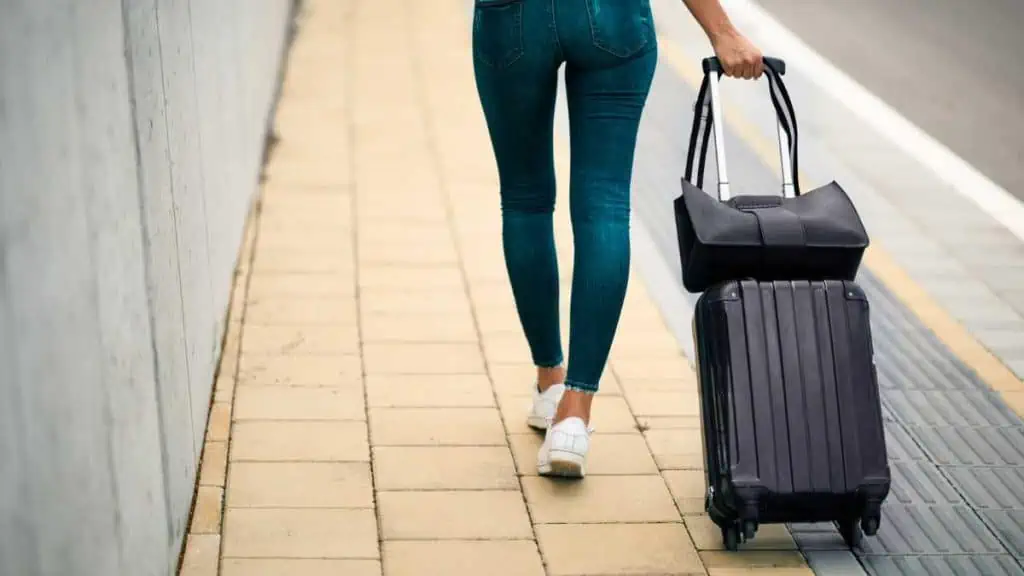Have you ever been puzzled by the term “personal item” while preparing for a flight?
In air travel, a personal item is not just any random object you hold dear. It’s a specific type of luggage, typically smaller than a carry-on bag, designed to fit snugly under the seat in front of you during your flight.
Understanding what qualifies as a personal item is key to packing smart and adhering to airline guidelines, which will make your travel experience smoother and more efficient.
Well, we’ll be going over:
- What qualifies as a personal item, and how does it differ from a carry-on bag?
- What are the typical size restrictions for personal items across different airlines?
- How can you maximize the utility of your personal item to enhance your travel experience?
Let’s embark on this journey of understanding and make your next trip a breeze!
What Is Considered A Personal Item?: A personal item in air travel is a small bag like a purse, laptop bag, or backpack that fits under the seat in front of you. It serves as secondary luggage alongside your carry-on bag. Size restrictions vary by airline, typically around 17 x 13 x 8 inches. Always check airline guidelines for specific size limits.

Contents
What Is Considered a Personal Item?
A personal item is a type of hand luggage that you, as a passenger, can bring onto a plane. It’s meant to be smaller than a carry-on and fit comfortably under the seat in front of you.
Airlines usually have specific size constraints, but these can vary between companies. Personal items include small backpacks, purses, briefcases, laptop bags, camera bags, and fanny packs.
When it comes to size, a standard industry measurement is roughly 17 x 13 x 8 inches. However, checking your airline’s requirements is essential, as under-seat storage space might differ slightly. Most airlines give general guidance on their personal item policies so you know what to expect before you board your flight.
Some airline personal item size examples:
- American Airlines: 18 x 14 x 8 inches
- British Airways: 16 x 12 x 6 inches
- JetBlue: 17 x 13 x 8 inches
- Frontier: 18 x 14 x 8 inches
- Hawaiin Airlines: Must fit under the seat in front
Your personal item can be a secondary bag in addition to your carry-on luggage, provided your airline allows it. Remember that if you’re traveling on a Basic Economy fare, you might be restricted to just one personal item with no carry-on bag, depending on the airline.
To make the most out of your personal items, pack essentials and items you might need during your flight, such as your passport, medication, a book or tablet, headphones, and snacks.
Common Types of Personal Items

Many objects can fall into this category when you think of personal items. Generally, a personal item belongs to you, is small enough to be easily carried, and has specific rules, regulations, and policies governing its use.
Let’s look at some examples of personal items you might bring on a flight or pack in your daily bag.
1. Purses and Wallets
Purses and wallets are essential for carrying your identification, cash, credit cards, and other important personal belongings. They come in various sizes and styles, so choose one that fits your needs and the rules of the specific airline you’re flying with.
2. Laptop and Tablet Bags
Many travel with laptops or tablets, especially for business trips or extended stays. A laptop or tablet bag is designed to protect your device and facilitate its transportation. These bags usually fit under the seat in front of you on an airplane, making them an ideal personal item.
3. Backpacks and Totes
Backpacks and totes are versatile and functional bags, perfect for carrying essentials like snacks, books, and spare clothing. As long as they meet the airline’s size guidelines, they can be considered a personal item for your trip.
4. Briefcases
A briefcase is another common personal item, especially for business travelers. It’s a stylish way to transport and organize your documents, pens, and other office supplies while on the go.
5. Camera Bags
Whether you’re a professional photographer or just capturing memories on vacation, a camera bag is a must-have for keeping your expensive equipment safe and organized. Ensure it fits within the airline’s personal item size requirements before embarking on your journey.
Airline Regulations for Personal Items

Size and Weight Restrictions
It is important for travelers to be familiar with the size and weight restrictions for personal items on airlines. Personal items must fit under the seat in front of you, and different airlines have specific dimension requirements to ensure this.
For instance, American Airlines limits personal items to no more than 18 x 14 x 8 inches (45 x 35 x 20 cm), while on United Airlines, the limit is 17 x 10 x 9 inches (43 x 25 x 23 cm).
Most airlines do not enforce weight limits for personal items. Since personal items are usually small and lightweight, they are less likely to cause issues. However, it’s still a good idea to keep your personal items light and manageable for your convenience.
Allowed Contents
When packing your personal item, ensure that the contents are allowed by airline standards. Typically, personal items can include purses, small backpacks, briefcases, and other similar-sized bags.
Some airlines may also allow certain extra items that do not count as your personal item or carry-on, including:
- Diaper bags (1 per child)
- Small, soft-sided cooler with breast milk
- Breast pump
- Child safety seats
- Strollers (How to gate check a stroller)
- Medical or mobility devices
Remember that airline regulations may differ, so it’s a good idea to look up the specific rules of the airline you are flying with to avoid any misunderstandings or delays. This will help ensure a smooth and hassle-free journey as you bring your essential personal items.
Tips for Packing a Personal Item
When preparing for your next trip, consider these tips for packing a personal item to ensure a seamless travel experience.
Maximizing Space
To fully utilize the space in your personal item, select a bag with multiple compartments and pockets. This will help keep your belongings organized and easily accessible.
- Roll your clothes instead of folding them to save space and avoid wrinkles.
- Use packing cubes or compression bags to separate items and maximize the available space.
- Wear your bulkiest items, like jackets and boots, during travel to free up space in your personal item.
Organizing Essentials
Maintaining essentials is crucial as you must access certain items quickly during your trip.
| Category | Items |
|---|---|
| Travel Documents | Passport, boarding pass, itinerary, lodging information |
| Electronics | Phone, charger, headphones, power bank |
| Health & Hygiene | Hand sanitizer, tissues, face mask, medications |
Use clear plastic bags or zippered pouches to store these items in easily accessible compartments for quick travel retrieval.
Adhering to Airline Guidelines
When packing your personal item, it’s essential to adhere to airline guidelines. The most common size allowance is 18 inches x 14 inches x 8 inches, but it’s important to confirm with your specific airline.
Ensure your bag fits under the seat before you and does not exceed any weight restrictions. Depending on your travel needs, a personal item can be a backpack, tote bag, briefcase, satchel, laptop bag, or even a purse.
Being mindful of these guidelines while packing your personal item will make your travel experience smoother and avoid any unnecessary inconveniences at the airport.
Personal Item Vs Carry-On

Understanding the difference between a personal item and a carry-on can save you time and hassle at the airport. Generally, the key difference between the two lies in their size and the types of belongings they are designed to carry.
A personal item is a smaller bag than a carry-on bag that you carry onto the plane with you. It must fit under the seat in front of you. Examples of personal items include purses, satchels, and small backpacks. These bags carry delicate or essential items such as laptops, cameras, snacks, medication, and books.
On the other hand, a carry-on bag is larger and is intended to be stored in the overhead compartment during a flight. Common types of carry-on bags include duffel bags, rolling suitcases, and larger backpacks.
A carry-on is designed to hold more items, such as clothing and shoes, for short trips or as a supplement to checked luggage for longer journeys.
Personal Item FAQs
Is a backpack considered a personal item?
A backpack provided it is not a huge hiking backpack, will be considered a personal item. It must fit under the seat in front.
Can a duffel bag be a personal item?
A backpack will be considered a personal item, provided it is not huge. It must fit under the seat in front.
What if my personal item is too big?
If your personal item is considered too large, it will probably have to travel as hold luggage. You may have to pay separately for it to go into the hold.
Is a pillow considered a personal item?
Some airlines consider a full-size pillow a personal item. A small pillow that wraps around your neck probably won’t count, particularly if you wear it when you board.
Is a teddy bear considered a personal item?
If it is not a giant teddy bear, then it is unlikely that it will count as a personal item.

I have been traveling around the world by air since the early 70s and living overseas too. I worked for British Airways for a number of years and I am also a private pilot. About Me


